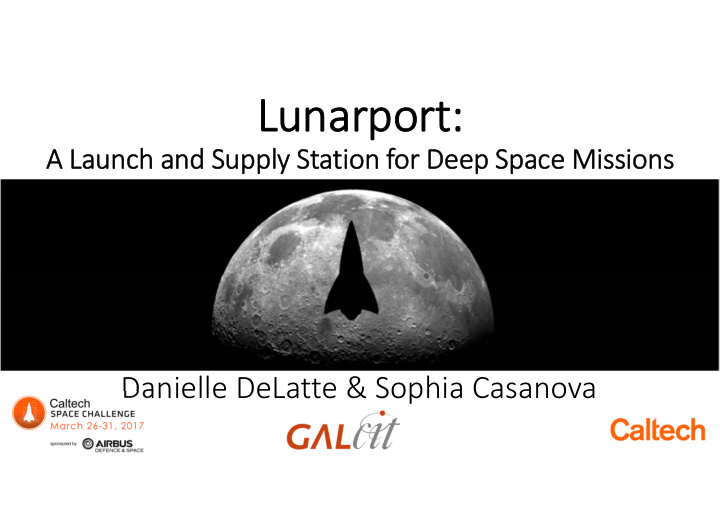



Lunarport: Lunarport: A Launch Launch and and Supply Supply St Station ion fo for Deep Deep Space Space Mi Missions ns Danielle DeLatte & Sophia Casanova
What is the Caltech Space Challenge?
LUNARPORT LUNARPORT Design a launch and supply station for deep • space missions Extract water resources from the Lunar • poles Budget – 1 billion/year • Autonomous/remote construction and • operation
Lunar South Pole Ice Days of sunlight over a month (Sanders 2016) Key Operational Considerations • Stable surface (near subsurface) ice resources located in permanently shadowed regions (PSRs) – temperatures < 100 K Net DTE visibility over a month (Sanders 2016) • Limited sunlight • Limited direct to Earth (DTE) communication LRO Diviner South Pole Temperature Map (Credit: NASA/JPL)
The Teams Proposals Team Voyager Team Explorer
Team Voyager – Mining Operations Example of a mining rover in action Team Voyager – Overall Mission Timeline Team Voyager – Base and Mining Site Design Production Requirements: ‐ 2028 ‐ Produce 45.2 t of water – technical demonstration ‐ 2032 ‐ Produce 700 t of water (2 Cargo missions to Mars) ‐ 2034 ‐ Produce 175 t of water (Crewed mission to Mars)
Team Voyager – Mission Design Operational Requirements: ‐ LRS transports resources from the lunar surface to cis ‐ lunar space (L1) ‐ Depot receives water from the LRS and converts to LO2 and LH2 through electrolysis ‐ Depot provides docking capability for customer spacecraft Team Voyager ‐ Lunar Resupply Shuttle (LRS) Timeline
Team Voyager – Mission Design Operational Requirements: ‐ LRS transports resources from the lunar surface to cis ‐ lunar space (L1) ‐ Depot receives water from the LRS and converts to LO2 and LH2 through electrolysis ‐ Depot provides docking capability for customer spacecraft Team Voyager – Mission Design
Key Trades for Team Voyager • Site selection • Power production • Mining operations and equipment design • Maintenance • Modularity • Location and methods of transfer, propellant processing and storage
Team Explorer – Concept of Operations Operations: ‐ Four launches deliver the power station, mining rovers, and processing unit to the lunar surface ‐ Bases in three locations (two rim stations for power, one for mining) ‐ Fuel is launched to LLO ‐ Rendezvous with Mars missions
Team Explorer – Concept of Operations Operations: ‐ Four launches deliver the power station, mining rovers, and processing unit to the lunar surface ‐ Bases in three locations (two rim stations for power, one for mining) ‐ Fuel is launched to LLO ‐ Rendezvous with Mars missions
Team Explorer – Location NASA Cabeus Crater: the only Lunar location with verified H 2 O in minable quantities Paige+ 2010
Team Explorer – Mining Operations Bases: ‐ Two power stations will be set up to beam power to the rovers from the crater rim ‐ Between the two rim power stations, full power coverage for all of the rovers is available. ‐ Mining operations take place in the permanently shadowed region near (but not too near) the LCROSS impact that verified the existence of water on the moon Left: Slopes, Right: Elevation ( ‐ 4 ‐ > +4 km), 500 m contour
Key Trades • Rendezvous orbit • Location of mining operations • Storage • Maintenance • Power production • Economics/sustainability • Future human mission ‐ friendly
People Development Team Explorer Team Voyager
Global Context Credits (from top right, then clockwise): ESA, ispace, Moon Express, SpaceX
Summary • Power, economics, and communication were key challenges • Geological uncertainty with water content • Desire to act as catalyst for other missions and be future friendly • More information: • 10th IAA Symposium on the Future Of Space Exploration: Towards The Moon Village And Beyond, June 27 ‐ 29th 2017. ” Lunarport Concept ‐ A Launch And Supply Station For Deep Space Missions: A Comparative Study Of The Two Concepts Developed At The 2017 Caltech Space Challenge ” • The Conversation (online magazine), May 15, 2017. “ Mining the Moon for Rocket Fuel to Get Us to Mars ” https://theconversation.com/mining ‐ the ‐ moon ‐ for ‐ rocket ‐ fuel ‐ to ‐ get ‐ us ‐ to ‐ mars ‐ 76123 • AIAA Space Forum 2017. ” 2017 Caltech Space Challenge ‐ Lunarport: Lunar Extraction for Extraterrestrial Prospecting (LEEP): Enabling Deep Space Exploration with an In ‐ Space Propellant Depot Supplied from Lunar Ice ” Read More: https://arc.aiaa.org/doi/abs/10.2514/6.2017 ‐ 5375 • AIAA Space Forum 2017. “Enabling Deep Space Exploration with an In ‐ Space Propellant Depot Supplied from Lunar Ice ” Read More: https://arc.aiaa.org/doi/abs/10.2514/6.2017 ‐ 5376 • Caltech Space Challenge website for final reports, presentations, and videos: http://www.spacechallenge.caltech.edu/final ‐ results
Thank Thank yo you to to the the or organiz nizers, participan participants, ts, and and spo sponso sors!
Similarities & Differences Voyager Explorer Site Selection 500m NW of Shackleton Crater Cabeus Crater, permanently shadowed region Rovers Exploration (1), Building (2), Mining (16) Exploration (2) , Building (2), Mining (12) Mining operation design 3 ‐ prospect site model, base located in sunlit One initial site for mining, power beamed from two crater rim region stations Propellant transfer (on Electrolysis for LRS on surface Electrolysis for LRS on surface lunar surface) Transfer water to orbit depot Transfer water to refuel in orbit Fuel stored in LRS vehicles Power Prospecting rover – Nuclear All rovers use solar power beamed from two crater rim Base ‐ Solar stations Mining Rovers – Battery and Microwave beamer technology (wireless transfer) Refueling clients (orbits, L1 Depot – electrolysis in orbit LLO, low ‐ periapsis elliptical orbit around Earth, rendezvous transfer method) with Mars mission’s spacecraft Modularity Module design – allows flexibility of design Module design – more launches/rovers can be added to increase production, good mission for Mars, GREAT for deep space missions
Recommend
More recommend